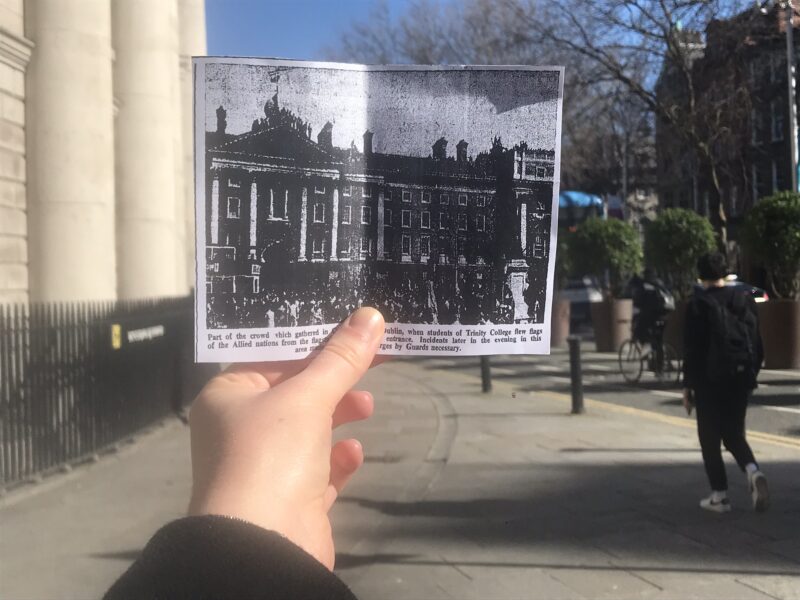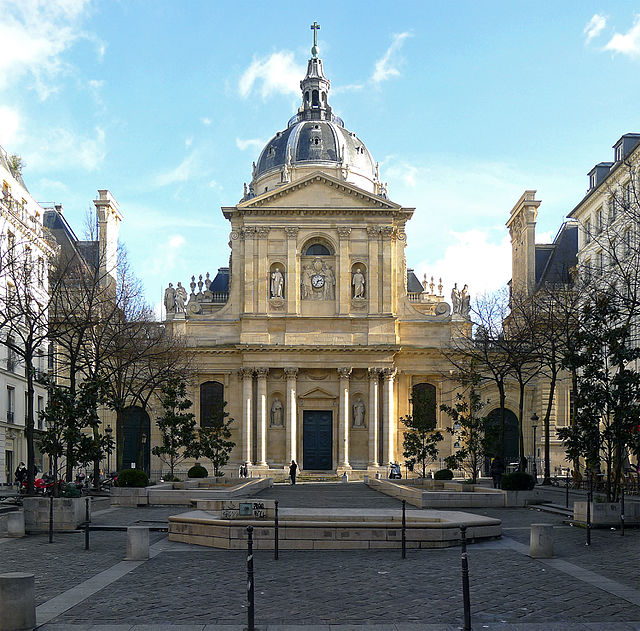After the announcement of the surrender of Nazi Germany in May, 1945, Trinity found itself at the centre of days of riots incited by the fascist party Ailtirí na hAiséirghe and joined by passers-by on the street. The riots, provoked by a celebration of the Allied victory by Trinity students which insulted the Irish flag, involved open displays of aggressive, pro-Axis sentiment, yet much of the press censure was reserved for the students, for whom the Provost apologised and from whom many fellow Trinity students publicly tried to disassociate themselves.
Dr Gillian O’Brien, a lecturer in Irish history at Liverpool John Moores University, notes how the riots provide “a really interesting snapshot of Ireland in the mid-1940s”.
On the afternoon of May 7th, 1945, between 50 and 150 Trinity students appeared on the roof over Front Arch and started to cheer, hang bunting, and sing songs such as “God Save the King” and “La Marseillaise”. They raised the flags of the four main Allied nations, and the Irish flag at the bottom. Dr O’Brien explains that there was a similar flag demonstration at the end of the First World War, which resulted in rioting and fights between Trinity and University College Dublin (UCD) students on Grafton St, “sticks and bottles and all sorts of things were thrown” and for years afterwards people would sometimes hang around Trinity wondering if such scenes would repeat themselves.
On this occasion, a gathering crowd in College Green, joined by a procession of members of Ailtirí na hAiséirghe, “took exception” to the position of the Irish flag. Aiséirghe staged an anti-Trinity demonstration in the street, burning a Union Jack. In response to this some students on the roof set the Irish flag alight, after which attacks on College began, including fights between Trinity students and Aiséirghe, joined by outraged passers-by. Members of the crowd, which reportedly grew to 1,000 people, repeatedly attempted to charge into Trinity, but were stopped by the Gardaí, who baton charged them.
The unrest spread, with about 50 men attacking the Wicklow Hotel on Dame St shouting, “give us the West Britons” and “put out the traitors” until they were fought out by bellboys. In a different procession from Aiséirghe, crowds were witnessed doing fascist salutes and sanging Amhrán na bhFiann before stoning the windows of Jammet’s restaurant on Nassau St (known for its Free French, pro-de Gaulle sympathies and its pro-British customers). Later that night, the same happened to both the British and American embassies. The new Italian envoy to Ireland noted the swastika badges in some participants’ buttonholes, and swastika flags being waved.
Members of the crowd, which reportedly grew to 1,000 people, repeatedly attempted to charge into Trinity, but were stopped by the Gardaí, who baton charged them
Prof Raymond Douglas, a history professor at Colgate University New York, explains that Aiséirghe were “the prime movers” in these events, and though many demonstrators were not members, the riots probably would not have happened without their instigation.
Founded in 1942, their members were examples of what Douglas calls “the generation of 1940” who felt that “parliamentary democracy was an outmoded 19th century idea… a luxury that especially an impoverished country could not afford”, and looked abroad to continental dictatorships, mostly fascist but also sometimes communist, for inspiration.
Disseminating antisemitic propaganda and advocating a Catholic, corporatist dictatorship where speaking English would eventually be forbidden and Ireland would be “a missionary, ideological state” and an example to the rest of the world, they were on the extreme end of what Dr Trisha Oakley Kessler, research associate at the Woolf Institute in Cambridge University, describes as the 1930s “narrowing of an Irish identity predicated on the idea of being Roman Catholic, rural, Gaelic”.
Part of this narrowing was the “othering of Jews” and the intensification of the two strands of antisemitism that Kessler identifies as being prevalent in Ireland before the war: Christian antisemitism, portraying Jews as “Christ-killers”, and racial antisemitism, “particularly through the lens of Jews’ relationship to money and power”, portraying Jews as “materialistic”, “representing capitalism” and “the worst bits of the Enlightenment”, while also being “paupers, degenerates, criminals” involved in Masonic and/or Bolshevik conspiracies.
However, these views were not specific to Aiséirghe and extreme Catholic action movements: ordinary business voices had relayed such prejudices back to those higher up, highlighting how they, unlike Jewish businesses, were “just and Christian”. While Kessler points out that many workers didn’t care if employers were Jewish so long as they had work, and there was some “positive engagement with diversity on the ground”, the prevalence of antisemitism in Ireland may have made Irish people indifferent to the fate of Jews under Nazi rule: “It’s very telling that there wasn’t huge pressure on the Irish government to open up to refugees… Being Jewish mattered when it came to whether you got your visa application or not.” Very few Jewish refugees were accepted by the Irish Free State.
It’s very telling that there wasn’t huge pressure on the Irish government to open up to refugees… Being Jewish mattered when it came to whether you got your visa application or not
Douglas does not think the VE Day demonstrators were representative of the Irish in 1945, though there was “every reason to believe there was a pro-Axis majority” in Ireland in 1940 and 1941, when an Axis victory looked likely. Irish opinion “mutated and changed in the course of the war” and when an Allied victory became the obvious outcome there was a “bandwagon effect”. Nonetheless there was “a great deal of chagrin” at that victory for those who retained their pro-Axis sympathies, as was evident from the riots.
On the second night of rioting the crowd grew to “several thousand” people. About 200 students from the National University attempted to climb over the Trinity railings on Nassau St to hoist the tricolour, and there was a pitched battle between female students of opposing sides in front of the college gates. The crowd smashed the Trinity windows with volleys of stones, and aimed fireworks and smoke-bombs at Gardaí, who baton-charged them another several times.
Despite this damage, Trinity received little sympathy, newspaper reactions reserved more censure for the burning of the Irish flag by a few Trinity students than for the days of rioting. In the Sunday Independent, P.S. O’Hegarty stated that “all sorts and conditions of people” resented the insult to the Irish flag. The Irish Press called the actions of the students on the roof “disgraceful” and said they “dishonoured” Trinity and Dublin. Trinity hastily distanced itself from the initial celebrations and by May 10th, the Provost had publicly apologised.
O’Brien points out that the insult to the Irish flag was a far more provocative action than it might seem now, but the Cork Examiner reports of Swastikas on demonstrators’ lapels does rather “cast a pall” over the later boasts of defending the Irish flag from UCD students involved in the rioting. In the 1930s, says Kessler, “persecution was clear”, however with the 1940s censorship things get more difficult, with some referring to reports of the concentration camps as “British propaganda”.
The significance of Aiséirghe at this time for Douglas is not so much the very low chance that that party would achieve electoral success, but the question of “how many of Aiséirghe’s beliefs – be they antisemitic, anti-democratic, pro-Axis – one could have and still be in the mainstream? The answer to that question is obviously quite a high number”, explains Douglas. Respected Fine Gael, Fianna Fáil and even Labour politicians often held these beliefs. Douglas points to the Fine Gael 1943 Ardfheis discussions on “the Jewish question” as an example of this.
The crowd smashed the Trinity windows with volleys of stones, and aimed fireworks and smoke-bombs at Gardaí, who baton-charged them another several times
Kessler notes worryingly that those involved in antisemitic, pro-Axis groups often ended up in positions of influence later. “It’s easy to say, ‘they were nutcases, they were fanatics’” and that the extreme anti-Semites were just “groups on the margins”, but “if there’s so many groups on the margins”, it adds up. Kessler goes on to describe how assessing antisemitism in Ireland had less to do with counting acts of violence by fanatical individuals, or with pointing at certain people and asking, “was he/she antisemitic?” and more to do with “cultural codes about what it was to be Irish”, and the societal prejudices that grew more powerful at various points in history.
The Second World War remains a contentious and murky period in Irish history. There are many questions still to be discussed about Ireland and Irish opinions at the time, but for us at Trinity, a fascinating place to start is with the events that happened on and around our own campus 76 years ago.







